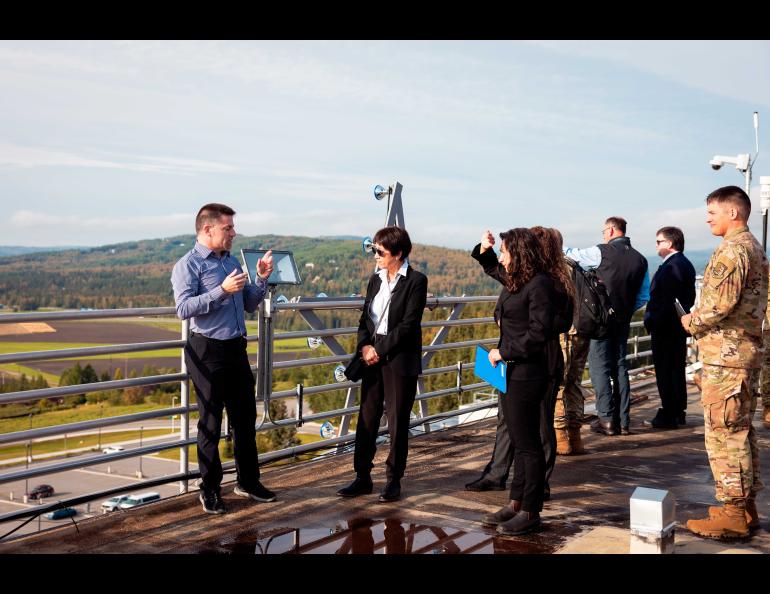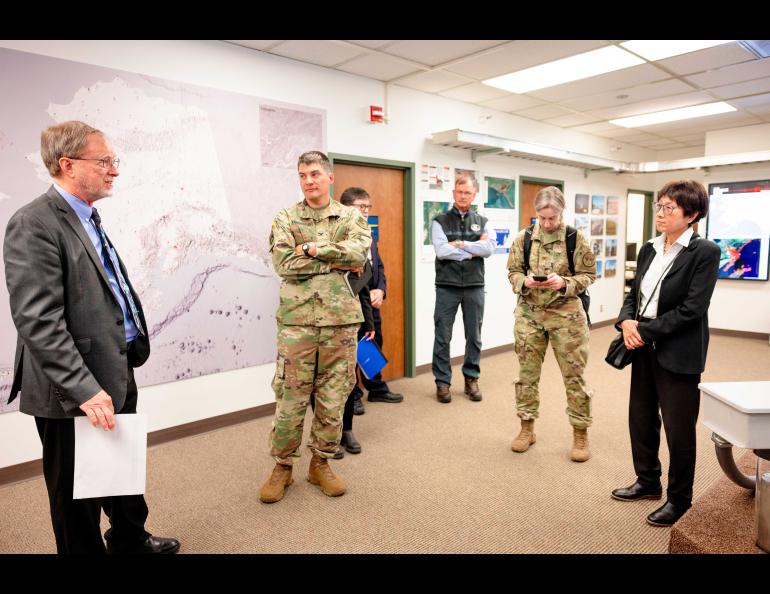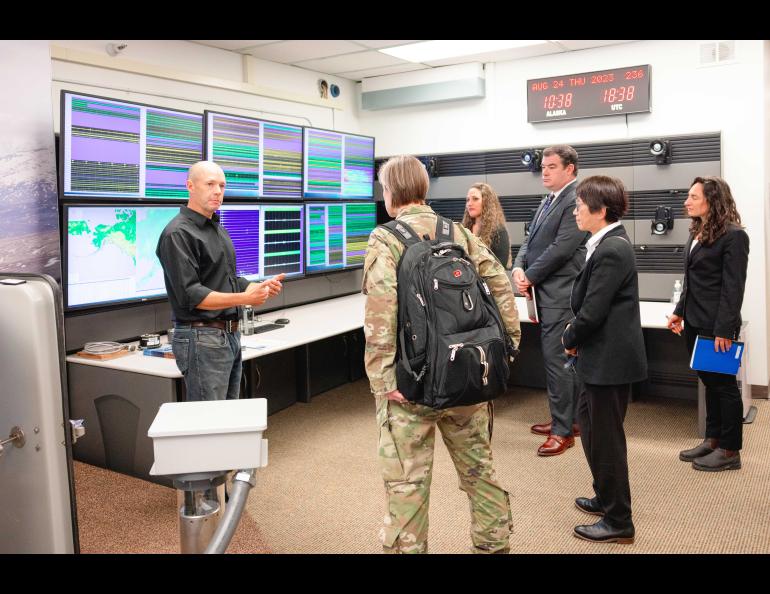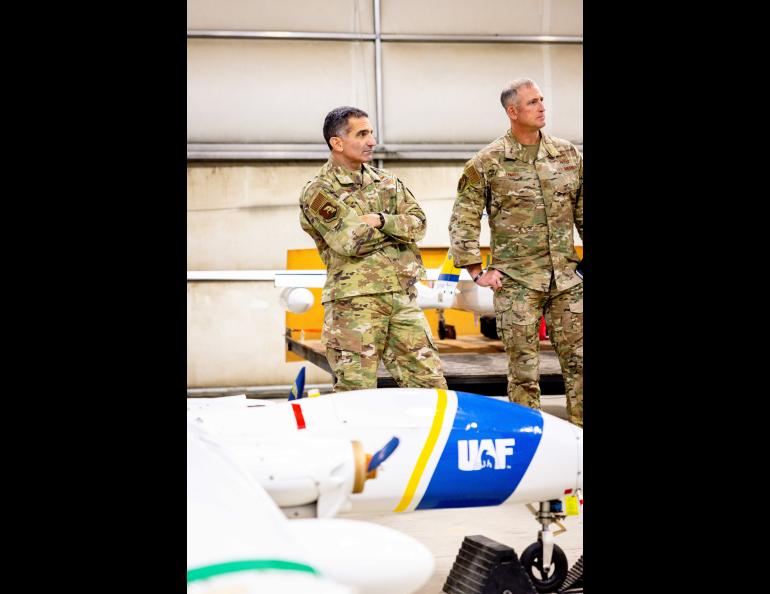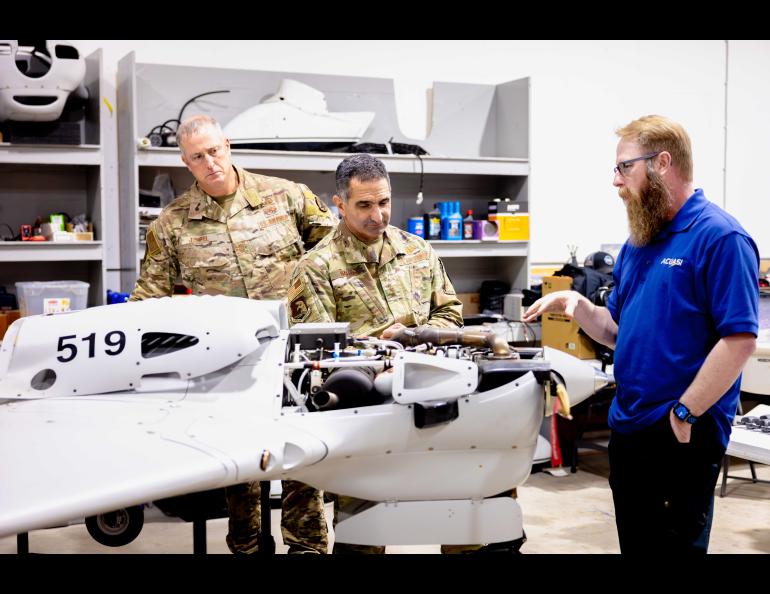Top Department of Defense civilian and military leaders visited the University of Alaska Fairbanks Geophysical Institute in late August and learned about the numerous ways the institute’s facilities and researchers support the nation’s defense in the Arctic.
Undersecretary of Defense Heidi Shyu visited on Aug. 24, and Air Force Lt. Gen. David Nahom, commander of the Alaskan Command, visited on Aug. 30.
“The visits by such high-level Defense Department officials provided another opportunity to showcase all that the Geophysical Institute and its people have to offer in service to the public, and that includes activities related to national defense,” Geophysical Institute Director Robert McCoy said after the visits concluded.
Shyu, undersecretary of defense for research and engineering, toured the Geophysical Institute’s home building at UAF. She also visited the Fairbanks airport at the hangar of the institute’s Alaska Center for Unmanned Aircraft Systems Integration.
Shyu is the department’s chief technology officer and is responsible for the research, development and prototyping activities throughout the department. She also oversees the activities of the Defense Advanced Research Projects Agency, the Missile Defense Agency and the Defense Innovation Unit.
UAF Chancellor Dan White gave an overview of the university at a morning presentation. UAF Vice Chancellor for Research Nettie La Belle-Hamer then broadly described UAF’s research areas. McCoy informed Shyu and those traveling with her about the institute’s capabilities, facilities and some of the work it does with the Defense Department.
Shyu visited the institute’s Alaska Satellite Facility, Alaska Earthquake Center and the Wilson Alaska Technical Center. She also visited the Permafrost Tunnel Research Facility, which is maintained by the Army Corps of Engineers off campus.
Shyu also participated in a domain awareness roundtable discussion that included McCoy; Andy Mahoney, research assistant professor of the institute’s Snow, Ice and Permafrost Group; Keith Dunkle, executive director of the UAF Geophysical Detection of Nuclear Proliferation University-Affiliated Research Center; and Jessica Matthews, director of the High-frequency Active Auroral Research Program.
Nahom, as commander of the Alaskan Command, oversees all military forces in Alaska. The Alaskan Command, headquartered at Joint Base Elmendorf-Richardson in Anchorage, includes more than 20,000 Air Force, Army, Navy and Marine personnel and 4,700 Guardsmen and Reservists.
Nahom, accompanied by several Alaska Command personnel, had an itinerary similar to that of Shyu.
During the morning’s presentation, again by McCoy, Nahom was particularly interested in higher education for military personnel.
McCoy mentioned online courses that can lead to a certificate in space weather, particularly for personnel in the U.S. Space Force. He also said the university is trying to encourage military personnel to obtain a Ph.D. in space physics through the Geophysical Institute.
Nahom also participated in a domain awareness roundtable, which included the subject of UAPs — unidentified anomalous phenomena.
An airborne object shot down by the U.S. military over Alaska’s Arctic Ocean in mid-February showcased the ability of the Geophysical Institute to aid the federal government’s Arctic awareness.
As the situation developed, the Alaskan Command and the Geophysical Institute had discussions about the ability of the institute to assist in locating the debris.
Geophysical Institute experts quickly organized to provide information about sea ice, snow, lidar, hyperspectral sensing, Arctic weather, synthetic aperture radar satellites and uncrewed aircraft systems. Although the military ultimately decided to not use the institute’s resources, the incident highlighted the institute’s ability to assist the Defense Department.
“We want the Geophysical Institute, and all of UAF, to be the place the Defense Department turns to for all things Arctic — advice, technical assistance and access to industrial capabilities,” McCoy said.
